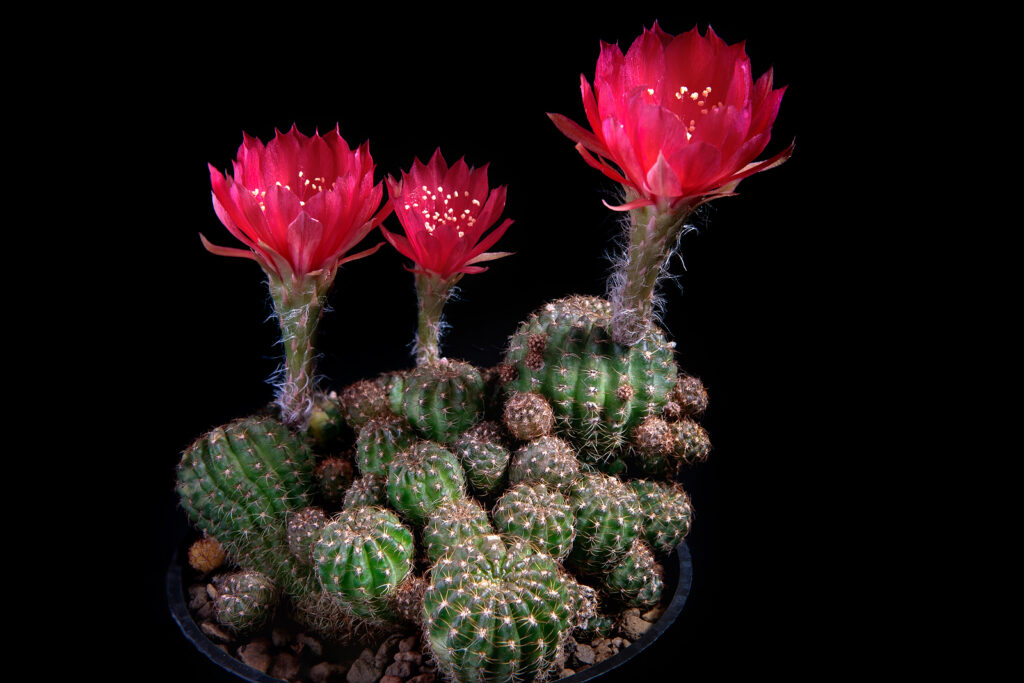Lobivia–commonly called cob cactus–is a small globular or cylindrical cactus with large showy flowers. The flowers are day bloomers and last only a day or two before new flowers appear.
Lobivia forms wooly brown buds on the side of the plant in spring; flowers follow. Flower colors range from shades of red, yellow, or orange to a true purple.
Lobivia is often hybridized, particularly with the genera Rebutia and Echinopsis. Lobivia is often listed with the botanical names Echinopsis or Rebutia.
There are about 70 species of Lobivia. Lobivia does well in window gardens or on tabletops.
Get to know Lobivia
- Plant type: Cactus, hedgehog cactus
- Hardiness temperature: 25℉ (-3.9℃).
- Optimal growing temperature is: day, 70°F (21°C); cooler at night.
- Shape and size: Grows to 12 inches (30cm) tall with globular or cylindrical form
- Flowers: Funnel-shaped day blossoms in shades of red, yellow, orange to true purple; dayblooomers, growing on short, hairy tubes, last only a day or two; new flowers appear quite regularly.
- Bloom time: Summer
- Common name: Cob cactus
- Genus name: Lobivia
- Family name: Cactaceae
- Origin: Argentina

Planting Lobivia
- Lobivia needs a light, bright sunny, and airy location. It can also grow in partial shade
- Protect Lobivia from harsh, burning sun.
- Plant Lobivia in sandy loam mixed with pumice stone and perlite.
- Indoors grow Lobivia in a cactus/succulent soil mix.
- Grown indoors Lobivia requires more light than the typical houseplant; place it in a sunny window. Bright light from southern or western exposure is best. Air circulation is important.
How to water and feed Lobivia
- Water Lobivia a little more than other cacti. Let soil dry between thorough waterings. Avoid overwatering. Keep Lobivia dry during the winter.
- Lobivia prefers humidity of 30% to 45%.
- Feed Lobivia every 2 weeks during growing season, with high-potassium fertilizer.
Lobivia care
- Lobivia only bloom when kept dry and between temperatrues of 39 and 46℉ (4-8℃).
- Check for aphids, mealybugs, spider mites, scale. Also be alert for fungus disease. Lobivia is susceptibe ot red spider mites.
- Repot Lobivia when pot space is overcrowded, in spring.
- Propagate Lobivia through seeds or cuttings; it is sometimes grafted.
- Lobivia has a thickened tapott and is prone to rot.
- Lobivia want a rest during winter. Place Lobivia in a cool location, 60°F (16°C), with maximum light. Water just enough to prevent plant from shriveling; withhold fertilizer.
- Propagate Lovivia by offsets or seeds.
Lobivia species to grow
- Lobivia allergraiana. Grows to 6 inches (15 cm) tall; green stem bears yellow-brown spines along ribs; flowers are pink to red.
- L. famatimensis. Small globe with shallow, cross-furrowed ribs and white spines. Flowers are red or yellow, sometimes white.
- L. f. densispina. Bears 20 or more radial spines; dark stems.
- L.f setosa. White, bristlelike radial spines; central spines are missing on this variety. Flowers are either red or yellow.
- L. hertrichiana. Grows 4 inches (10 cm) across; glossy green stem has a pattern of yellow-brown radial spines surrounding a curved, yellow central spine; flowers are brilliant red.
- L. jajoiana. Grows to 2 inch (5 cm) diameter; green stem features needlelike, red radial spines and black, hooked central spines; flowers are deep red.















